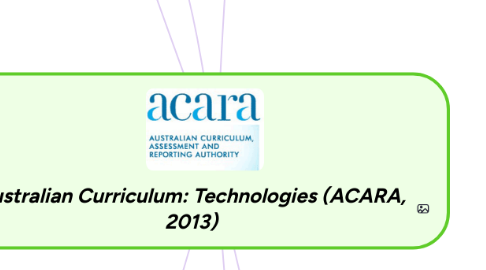
1. Aims
1.1. Knowledge, understanding and skills
1.2. Individual and collaborative work
1.3. Understanding of traditional, contemporary and emerging technologies
1.4. Student's make informed, ethical and sustainable decisions
1.4.1. Current needs
1.4.2. Future needs
1.4.2.1. Health and wellbeing
1.4.2.2. Recreation
1.4.2.3. Everyday life
1.4.2.4. Work environment
1.5. Student's develop
1.5.1. Innovation
1.5.2. Responsibility
1.5.3. Manipulation of technology
1.5.4. Creativity
1.5.5. Evaluation of skills
1.5.6. Problem solving
1.5.6.1. Design
1.5.6.2. Manage
1.5.6.3. Create
1.5.6.4. Produce
1.5.7. Investigation skills
1.5.8. Confidence
1.5.9. Decision making
2. Australian Curriculum: overarching objectives
2.1. General capabilities
2.1.1. Literacy
2.1.2. Numeracy
2.1.3. ICT
2.1.4. Critical and creative thinking
2.1.5. Personal and social capability
2.1.6. Ethical Understanding
2.1.7. Intercultural understanding
2.2. Diversity
2.2.1. English as an additional language or dialect
2.2.2. Gifted and talented students
2.2.3. Students with disabilities
2.3. Cross-curriculum priorities
2.3.1. Aboriginal and Torres Strait Islander histories and cultures
2.3.2. Asia and Australia's engagement with Asia
2.3.3. Sustainability
3. Integration
3.1. English
3.1.1. Literacy skills
3.1.2. Interpret
3.1.3. Describe
3.1.4. Read instructions
3.1.5. Discussions
3.2. Mathematics
3.2.1. Tables, lists, picture graphs, scatter plots and line graphs
3.2.2. Patterns and trends
3.2.3. Measurement
3.2.4. Shape and geometry
3.3. Science
3.3.1. Biological, chemical and physical
3.3.2. Real-world solutions
3.3.3. Apply scientific concepts
3.4. History
3.4.1. Contemporary and historical sources
3.4.2. Range of societies and cultures
3.5. Geography
3.5.1. Sort information and find patterns
3.5.2. Interact with digital systems
3.5.3. Interpret maps
3.5.4. Mapping vocabulary
3.5.5. Human endeavour
3.5.6. Interact with digital solutions
3.5.7. Interact with digital solutions
3.5.8. Interact with digital solutions
3.6. The Arts
3.7. Health and Physical Education
4. Student learning
4.1. Content description
4.1.1. Bands
4.1.1.1. Foundation to year 2
4.1.1.1.1. Experience and rich resources for learning
4.1.1.1.2. Directed and purposeful play
4.1.1.1.3. Imagine, virtual and real world
4.1.1.1.4. Use drawing and modelling to communicate ideas
4.1.1.1.5. Precise instructions
4.1.1.2. Year 3 and 4
4.1.1.2.1. Family, school and wider community
4.1.1.2.2. Give reason for actions
4.1.1.2.3. Sequence of ideas
4.1.1.2.4. Respond to design and computing problems
4.1.1.2.5. Diagrams and drawings of ideas
4.1.1.3. Years 5 and 6
4.1.1.4. Years 7 and 8
4.1.1.4.1. Physical, cognitive, social and emotional changes
4.1.1.4.2. Question conventions and values
4.1.1.4.3. Creating solutions to problems
4.1.1.4.4. Record ideas using a range of media
4.1.1.4.5. Sophisticated problem-solving activities
4.1.1.4.6. Relate specialist occupations
4.1.1.5. Years 9 and 10
4.2. Content Elaboration
4.3. Achievement Standard
5. Organisation of the curriculum
5.1. Subjects
5.1.1. Design and technologies
5.1.1.1. Knowledge and understanding
5.1.1.1.1. Technologies and society
5.1.1.1.2. Technologies in contexts
5.1.1.1.3. Materials and technologies specialisations
5.1.1.1.4. Food and fibre production
5.1.1.1.5. Engineering principles and systems
5.1.1.1.6. Food technologies
5.1.1.2. Processes and production skills
5.1.1.2.1. Critiquing, exploring and investigating
5.1.1.2.2. Generating, developing and evaluating ideas
5.1.1.2.3. Planning, producing and evaluating designed solutions
5.1.1.3. Aims
5.1.1.3.1. Design ideas and communicate
5.1.1.3.2. Creatively manipulate materials
5.1.1.3.3. Design solutions for different contexts
5.1.1.3.4. Roles and responsibilities of "technology" related occupations
5.1.2. Digital technologies
5.1.2.1. Knowledge and understanding
5.1.2.1.1. Representation of data
5.1.2.1.2. Digital systems
5.1.2.1.3. Interaction and impact
5.1.2.2. Processes and production skills
5.1.2.2.1. Managing and analysing data
5.1.2.2.2. Using digital systems
5.1.2.2.3. Specification, algorithms and implementation
5.1.2.2.4. Creating and interacting online
5.1.2.3. Aims
5.1.2.3.1. Solutions that meet the needs of societies, economies and environments
5.1.2.3.2. Computational thinking
5.1.2.3.3. Use digital systems efficiently
5.1.2.3.4. Apply protocols and legal practices
5.1.2.3.5. Communicate ideas
5.2. Key concepts
6. Curriculum Links & references
6.1. Draft Australian Curriculum: Technologies
6.1.1. ACARA Australian Curriculum, Assessment and Reporting Authority. [2013]. Draft Australian Curriculum: Technologies. Retrieved from http://www.australiancurriculum.edu.au/technologies/technologies-across-foundation-to-year-10
6.2. ACARA General capabilities
6.2.1. ACARA Australian Curriculum, Assessment and Reporting Authority. [2013]. General Capabilities. Retrieved from http://www.australiancurriculum.edu.au/GeneralCapabilities/Overview/General-capabilities-in-the-Australian-Curriculum
6.3. ACARA Cross-curriculum priorities
6.3.1. ACARA Australian Curriculum, Assessment and Reporting Authority. [2011]. Cross-curriculum priorities. Retrieved from http://www.australiancurriculum.edu.au/CrossCurriculumPriorities
7. Key Ideas
7.1. Creating preferred futures
7.1.1. Ethical, socially responsible and sustainable living
7.1.2. Holistic approach
7.1.3. Predict outcomes of technology decisions
7.1.4. Create solutions to current needs of humanity
7.2. Project management
7.2.1. Teach and empower students so that they can manage projects
7.2.2. Planning and evaluating
7.2.3. Risk assessment
7.2.4. Time and work plans
